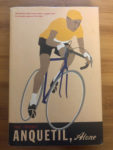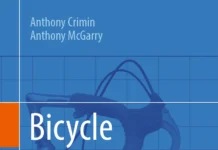Winter can be kind of rough for cyclists sometimes, at least for those who don’t have a winter sport that gets them outside. Winter can also be a good season for a little downtime, to either recover from the year’s efforts, or to take your mind off the mind-numbing chore of riding a trainer indoors.
As a fan of cycling as a sport, along with its history, I spend a good chunk of winter reading. Here are some my favorite books from past seasons, along with a selection of books that I’m planning to tackle this winter:
Fallen Angel: The Passion of Fausto Coppi, by William Fotheringham (2010, Yellow Jersey Press, ISBN #978-0224074506) — The rivalry between “Il Campionissimo” Fausto Coppi and Gino Bartali is the stuff of legends. Bartali was a deeply religious man who held his Catholic faith to heart. Coppi was of a more worldly and secular nature. The nation of Italy was divided along these lines, people were either bartalianis or coppianis. One of the reasons for this was Coppi’s scandalous personal life and affair with Giulia ‘la Dama Bianca’ Locatelli. Fotheringham does his usual excellent job telling the story of Coppi’s life and career while also exploring the scandal in an in-depth, and somewhat sympathetic light.
Put Me Back on My Bike: In Search of Tom Simpson, by William Fotheringham (2007, Yellow Jersey Press, ISBN #978-0224080187) — William Fotheringham is one of my favorite writers about the sport of cycling. His 2002 biography of Tom Simpson, the most successful British cyclist in the years before drug testing became widespread in the sport of cycling, is a fascinating read. Simpson tragically died on the Mont Ventoux during the 1967 Tour de France of a lethal combination of heat, dehydration, alcohol and amphetamines.
Tom, the true story of Tom Simpson, by Chris Sidwells (2000, Mousehold Press, ISBN #978-1874739159) — Chris Sidwell is Tom Simpson’s nephew, and his biography has more of a focus on Simpson’s family life as well as his career and presents a different point-of-view of the events leading up to Simpson’s death.
Anquetil, Alone, by Paul Fournel (2017, Pursuit, ISBN #978-1781257319) — Jacques Anquetil was the first professional cyclist to win the Tour de France 5 times, a feat officially matched since by only 3 other riders: Eddy Merckx, Bernard Hinault, and Miguel Indurain. Because of his aloof nature, Anquetil was not well-known nor well-liked by the French public, who preferred Raymond ‘the Eternal Second’ Poulidor. Paul Fournel is well-known as a poet in his native France, and that is instantly recognizable in his biography of Anquetil. Switching back and forth from the point-of-view of Fournel as a young fan of Anquetil, and imaginings of what was going on in Anquetil’s head as he prepared for certain events. Fournel’s biography is an emotionally evocative book that will give readers a better understanding of the French champion.
The Breakaway: My Story, by Nicole Cooke (2014, Simon & Schuster UK, ISBN #978-1471130359) — Few athlete memoirs are well-written, and fewer still are written by women athletes. That The Breakaway: My Story, by retired Welsh cyclist Nicole Cooke, is both means that the time it takes to read it is definitely well-spent. Nicole Cooke is a strong-willed, outspoken iconoclast. Like many top athletes, she knew what she wanted to accomplish, and was not going to let anything stop her from achieving everything she possibly could, even if she has to fight the system every step of the way. And fight she did, becoming one of the most decorated female road cyclists, not only in Great Britain, but in the world.
Both Merckx: Half Man, Half Bike, by William Fotheringham (2013, Chicago Review Press, ISBN #978-1613747261) and Merckx: The Cannibal, by Daniel Friebe (2012, Ebury Press, ISBN #978-0091943165) are highly recommended biographies of the greatest cyclist who ever lived. From his youth as the child of local grocers in the middle-class Brussels suburb of Woluwe-Saint-Pierre, through his career as a professional, these books give a lot of insight into how the man who won the Tour de Frace and Giro d’Italia five times each became “The Cannibal”.
The Rider, by Tim Krabbé (2003, Bloomsbury USA, ISBN #978-1582342900) — Quite frankly, most cycling fiction sucks; not because the stories are necessarily poorly written, but because they draw far too often from cycling history, with the plot either paralleling actual events or using stories to explain the nuances of cycling. The Rider is the rare exception to that rule. Krabbé, drawing from his own experience, dives deeply into the psyche of a racing cyclist during a one-day amateur race in the Massif Central of Southern France. It is perhaps the only piece of cycling fiction in which I’ve been able to imagine myself as the protagonist, because it so closely mirrored what goes on in my head when I’m on the bike. If you only read one book from this list, this is the one.
We Rode All Day, the Story of the 1919 Tour de France, by Gareth Cartman (2019, Gareth Cartman, ISBN #978-1916019706) — The 1919 Tour de France almost didn’t happen. While the Armistice was declared on November 11, 1918, the Treaty of Versailles, officially ending the war was not signed until June 28, 1919, just one day before the start of the race. Imagined and told from the perspectives of the riders and organizers of the 1919 Tour, this is not a typical historical recap of the race but attempts to take the reader into the minds of those who made the event special.
Riding in the Zone Rouge: The Tour of the Battlefields 1919, by Tom Isitt (2019, Weidenfeld & Nicolson, ISBN #978-1409171140) — Held in April 1919, less than 6 months after the Armistice was declared, the Circuit des Champs de Bataille has a reputation as the hardest stage race ever held; so hard, in fact, that it was only held the one time. A combination historical look back at the race and modern-day travelogue, Riding in the Zone Rougetraces the author’s own attempt to ride the course.
Slaying the Badger: Greg LeMond, Bernard Hinault, and the Greatest Tour de France, by Richard Moore (2012, VeloPress, ISBN #978-1934030875) — Greg LeMond was the first American to win the Tour de France, but it did not come easy. His most formidable rival and opponent was also his teammate, Bernard Hinault, whom LeMond had helped to become only the third person to win the Tour de France five times (and to date, the last Frenchman to win the Tour). Moore’s book really brings the Tour to life, crafting a story of the forging of an American sports hero.
The Badger: The Life of Bernard Hinault and the Legacy of French Cycling, by William Fotheringham (2015, Chicago Review Press, ISBN #978-1613734186) — Coming 30 years after Bernard Hinault became the last Frenchman to win the Tour de France in 1985, like his earlier works, Fotheringham brings us another fantastic biography of one of the legends of pro cycling.
Sunday in Hell: Behind the Lens of the Greatest Cycling Film of All Time, by William Fotheringham (2018, Yellow Jersey Press, ISBN #978-0224092029) — In 1976, the award-winning Danish filmmaker Jørgen Leth set out to capture the glory and the drama of Paris-Roubaix, one of the five Monuments of cycling, and the race that seems to capture the hearts and minds of cyclists because of its sheer brutality. Leth’s film, A Sunday in Hell, has earned its place not only as the greatest cycling documentary of all time, but as one of the greatest sports documentaries ever made. Fotheringham’s book looks back at how the masterpiece was created. It introduces the reader to the men behind the film, the techniques that made it possible, the places which have changed little over the preceding 40+ years, and to the riders that made the 1976 edition one for the ages.
The First Tour de France: Sixty Cyclists and Nineteen Days of Daring on the Road to Paris, by Peter Cossins (2017, Nation Books, ISBN #978-1568589848) — For over 100 years, the Tour de France has captured the minds of cyclists throughout the month of July. It is not the oldest race on the calendar, but it is certainly the most important. Many people know that the Tour was initially started in order to sell more newspapers; specifically of Henri Desgranges’s L’Auto. What fewer people know is how the idea of a Tour de France was conceived and realized. Cossin’s book explores the history of the times, as well as the men who made the race from organizer Géo Lefèvre to race winner Maurice Garin.
The Beast, The Emperor, and The Milkman: A bone-shaking tour through cycling’s Flemish heartlands, by Harry Pearson (2019, Bloomsbury Sport, ISBN #978-1472945044) — France may have the most important race on the international calendar, but one could argue that the sport’s heart and soul are the Flanders region of neighboring Belgium. Pearson’s book examines the people, the stories, the rivalries, and the places that make Flanders (and Flemish riders) so important to the history of the sport.
Editor’s note: some of these titles are out-of-print, but copies can be found online; others were not released in the US but are available through UK-based online retailers.






















